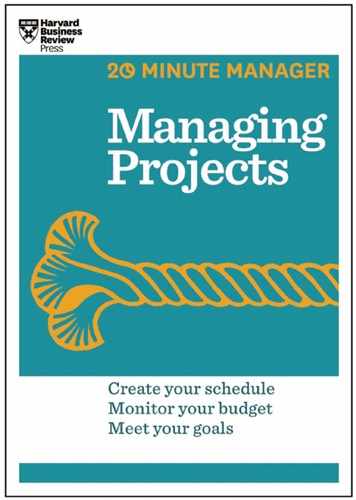Here are 10 multiple-choice questions to help you identify your baseline knowledge of project management. Answers appear at the end of the test.
1. You’ve been assigned a project, and it appears to have explicit expectations and clearly outlined responsibilities. Before you begin planning, what should you do?
a. Ensure that the funding has been approved.
b. Confirm that the project is solving the right problem.
2. Why is it critical to spend time early in the planning phase identifying all the stakeholders in your project’s activities or outcomes?
a. To find potential champions who will support the project.
b. To ensure that the project objectives meet everyone’s expectations of success.
c. To be politically astute and identify possible obstacles early.
3. This book advises you to beware of “scope creep.” What is scope creep?
a. Unwittingly giving in to pressure to do more than originally planned for.
b. Agreeing to extend the schedule without a corresponding increase in funding.
4. When you are defining project objectives, what three variables most often determine what you can achieve?
a. Resources, how realistic the project is, and availability of team members.
b. Complexity, time, and the expectations of stakeholders.
c. Scope, schedule, and budget.
5. What are you doing when you create a Work Breakdown Structure?
a. Dividing the overall project into smaller tasks and then subdividing those tasks further until you get to the desired task size.
b. Distributing the funding you have across the project objectives in order to anticipate personnel and activity costs.
6. When assembling a team for your project, make sure you have a group that:
a. Will get along during the project.
b. Is dedicated to the success of the project.
c. Has all the skills needed for the project.
7. You need to track what has to be done, how long each activity will take, in what order everything has to happen, and who is responsible for what. Which project management tool will do this?
a. Work Breakdown Structure.
b. Gantt or PERT charts.
8. Complete this statement: “A budget is not only a list of all the costs involved in executing a project but also ______.”
a. A summary of all the skills you need to complete the project.
b. A tracking tool that allows the manager to monitor implementation.
c. The tool that you as manager use to justify any future need for additional funds.
9. When developing budgets, project managers frequently overlook which of the following variables?
b. Travel
c. Supplies
d. Maintenance
e. Research or training
10. In the best of all possible worlds, who conducts the evaluation of a completed project?
a. The project manager, with all stakeholders providing input.
b. An independent person who can be objective.
c. The individual(s) who identified the initial problem and project.
Answers to test questions
1: b. Confirm that the project will indeed meet the organization’s underlying need. The expectations can be clear yet still not go to the heart of the issue. If that’s the case, you run the risk of wasting time and money on a project that is headed in the wrong direction.
2: b. You need to know exactly what success on the project means to people or departments who will be affected by its outcomes. One of your critical tasks in the planning phase is to meld stakeholders’ expectations into a coherent and manageable set of project objectives.
3: a. As you learn each stakeholder’s definition of success, you can get caught up in trying to solve problems that are beyond the scope of your project. Don’t give in to pressures to expand the project’s mission unless a majority of stakeholders see that expansion as essential, and even then, be sure you are given the additional time and budget required.
4: c. Scope, schedule, and budget are tightly linked. You can’t change one without changing at least one of the others and, potentially, the outcome of the whole project. The quality of the project’s deliverables depends heavily on the available time and funding.
5: a. You use a Work Breakdown Structure, or WBS, to subdivide a complex activity into smaller and smaller tasks until you reach a manageable task size. This becomes the basis for developing estimates, assigning personnel, tracking progress, and showing the scope of project work.
6: b. Your team needs to be committed to the project. The members may not always agree, but they have to trust that they are all working toward the same goals. A team is usually assembled according to its members’ skills, but having all the skills required is not necessarily the top priority when assembling a productive team. People can gain skills through training, and the team can supplement its skills with outside help when needed.
7: b. Both Gantt (bar) and PERT (flow) charts are generally accepted methods of scheduling projects. Use the method that suits you and the project; there’s no “right” way to schedule.
8: b. Experienced project managers monitor their budgets week in and week out to make sure their projects stay on track financially.
9: d. Maintenance is often forgotten because it’s not a standard budgeting category. But once you’ve completed a project, you may incur ongoing costs for maintenance and support, so it’s important to factor those in during budget development.
10: b. An outsider is usually the most objective evaluator. But if one isn’t available, the project manager should do the evaluation in a spirit of learning, not with an attitude of criticism and blame.
